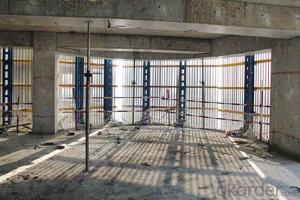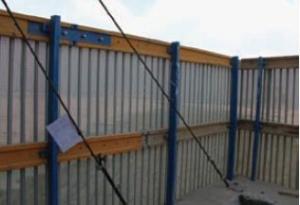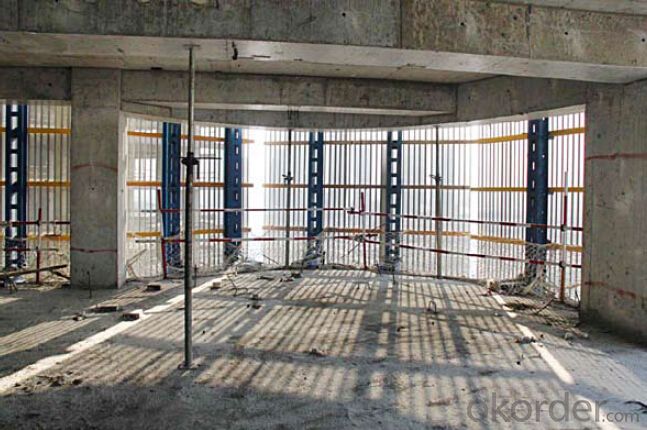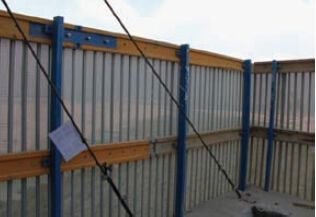Protection Platform for Formwork and Scaffolding Build
- Loading Port:
- Tianjin
- Payment Terms:
- TT OR LC
- Min Order Qty:
- 50 m²
- Supply Capability:
- 1000 m²/month
OKorder Service Pledge
OKorder Financial Service
You Might Also Like
Protection Platform PP-50
A kind of new type construction protection system, applying operating platform and safer job
location for construction corps.
Characteristics:
◆ Easy and quick assembling.
◆ Lifted as a group, it is rapid and economic.
◆ Auto-climbing
◆ A safe and reliable anchor system
1. Composition
2. Assembly process of anchor system
(1) Embed V-climbing cone and anchor plate into the slab.
(2) Fix anchor shoe on the slab by tensile bolt.
(3) The fixed anchor shoe.
◆ High work efficiency with work platform and unload platform
◆ High light transmittance with the hollow block
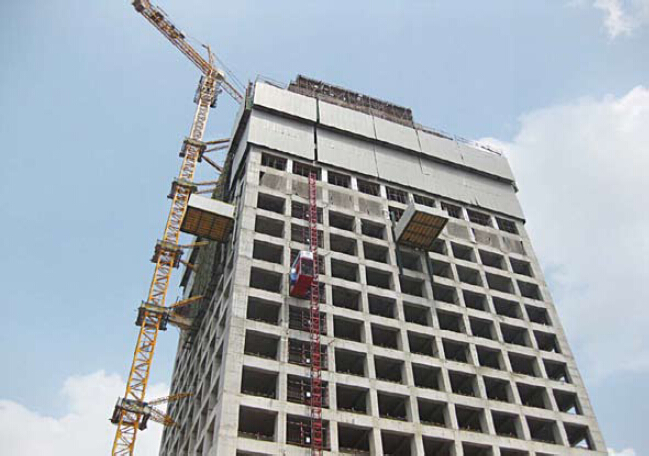

- Q: What are the different quality control measures for steel formwork construction?
- Some of the different quality control measures for steel formwork construction include regular inspections of the formwork for any defects or damage, ensuring that the formwork is properly aligned and leveled, checking for proper reinforcement and tie spacing, and conducting load tests to ensure the formwork can withstand the required loads. Additionally, quality control measures may involve monitoring the concrete pouring process, checking for proper curing of the concrete, and conducting regular checks on the formwork for stability and safety.
- Q: How does steel formwork contribute to the sustainability of the construction industry?
- Steel formwork contributes to the sustainability of the construction industry in several ways. Firstly, steel formwork is highly durable and long-lasting. Unlike traditional wooden formwork, which often needs to be replaced after a few uses, steel formwork can be reused multiple times, reducing the need for new materials and minimizing waste. This not only saves money for construction companies but also reduces the environmental impact of the industry by reducing the demand for timber. Secondly, steel formwork is more efficient and time-saving compared to other types of formwork. The use of steel allows for faster assembly and disassembly, reducing construction time and costs. This efficiency translates into reduced energy consumption and lower carbon emissions, thereby contributing to the sustainability of the construction process. Moreover, steel formwork offers flexibility and adaptability in design, allowing for the construction of complex structures with ease. This versatility reduces the need for additional materials and resources, as the same formwork can be used for various projects. This adaptability also minimizes construction waste, further enhancing the sustainability of the industry. Additionally, steel formwork has a high load-bearing capacity, enabling the construction of taller and stronger structures. This means that fewer materials are required to achieve the same structural integrity, reducing resource consumption and waste generation. The ability to construct more durable buildings also contributes to the long-term sustainability of the construction industry by reducing the need for frequent repairs or replacements. Lastly, steel formwork is recyclable. At the end of its lifespan, steel formwork can be easily and efficiently recycled, reducing the demand for new steel production and minimizing the environmental impact associated with its extraction and manufacturing. In conclusion, steel formwork contributes to the sustainability of the construction industry through its durability, efficiency, flexibility, load-bearing capacity, and recyclability. Its ability to reduce waste, energy consumption, and carbon emissions makes it an environmentally-friendly choice for construction projects, promoting a more sustainable and responsible construction industry.
- Q: How does steel formwork contribute to sustainable construction?
- There are several ways in which steel formwork contributes to sustainable construction: 1. Enhanced Durability: Steel formwork boasts remarkable durability and can be utilized multiple times, thereby minimizing the need for frequent replacements. This results in reduced material consumption and waste generation, making it an environmentally conscious choice. 2. Energy Efficient: In comparison to materials like wood or plastic, steel formwork requires less energy during the manufacturing process. As a result, it contributes to lower carbon emissions, thereby aiding in the reduction of greenhouse gas emissions. 3. Waste Minimization: By employing steel formwork, construction waste is minimized. Unlike traditional formwork materials that are often discarded after a single use, steel formwork can be easily disassembled, cleaned, and reused for future projects. This reduces the amount of waste sent to landfills and supports the concept of a circular economy. 4. Accelerated Construction Speed: Steel formwork is renowned for its speed and efficiency in construction projects. Its modular design allows for swift assembly and disassembly, thereby reducing construction time and energy consumption. Consequently, this minimizes disruption to the surrounding environment and lowers the overall carbon footprint of the project. 5. Enhanced Safety: Steel formwork provides a stable and secure platform for construction workers during the building process. Its strength and rigidity mitigate the risk of accidents and injuries, ensuring a safer working environment. This, in turn, leads to reduced healthcare costs and increased worker productivity. In summary, the utilization of steel formwork in construction promotes sustainability by diminishing waste, energy consumption, and carbon emissions. Its durability, reusability, and efficiency make it an invaluable option for sustainable construction practices.
- Q: Are there any specific considerations for using steel formwork in areas with high humidity?
- Yes, there are specific considerations for using steel formwork in areas with high humidity. High humidity can lead to increased moisture absorption by steel formwork, which can result in corrosion. To mitigate this, it is important to use steel formwork that has been properly treated with anti-corrosion coatings or galvanized to provide a protective barrier against moisture. Regular inspection and maintenance of the formwork is also crucial in high humidity areas to identify any signs of corrosion and take appropriate measures to prevent its progression. Additionally, ensuring proper ventilation and airflow around the formwork can help reduce the level of humidity and minimize moisture absorption.
- Q: Can steel formwork be used in areas with limited construction space or tight site constraints?
- Areas with limited construction space or tight site constraints can benefit from the use of steel formwork. This is because steel formwork is known for its versatility and adaptability, making it suitable for various construction projects, even those with limited space. One of the main advantages of steel formwork in these situations is its strength and durability. It can withstand high pressure and heavy loads, allowing it to be used in confined areas without compromising its structural integrity. This makes it an ideal choice for areas with limited construction space or tight site constraints. Additionally, steel formwork is highly flexible and can be easily adjusted or modified to fit the available space. It can be customized to different shapes and sizes, making it suitable for complex or irregularly shaped areas. This adaptability makes steel formwork a practical solution for construction projects with limited space. Moreover, steel formwork is reusable and can be dismantled and reassembled in different locations. This is particularly advantageous in areas with tight site constraints, as it allows the formwork to be easily moved and reused in different parts of the construction site. This not only saves time and effort but also reduces the need for additional formwork materials. Overall, steel formwork is a suitable choice for areas with limited construction space or tight site constraints. Its strength, adaptability, and reusability make it a practical solution for various construction projects, ensuring efficient and effective use of the available space.
- Q: What are the environmental considerations of using steel formwork?
- When considering the environmental impact of using steel formwork, several factors need to be taken into account. Firstly, the production of steel involves the extraction of iron ore, which can have negative environmental consequences. Mining activities can lead to deforestation, habitat destruction, and soil erosion. Additionally, the extraction process requires a significant amount of energy, often obtained from non-renewable sources, contributing to greenhouse gas emissions. Another environmental consideration is the transportation of steel formwork. Steel is a heavy material, and moving it from the manufacturing site to the construction site can result in increased fuel consumption and emissions. This is especially true in cases where the construction site is located far from the steel manufacturing facility. However, it is important to note that steel formwork can have several environmental advantages as well. Steel is a durable material that can be reused multiple times, reducing the need for new formwork production. This helps to minimize the demand for raw materials and reduces waste generation. Steel formwork can also be easily recycled at the end of its lifespan, further reducing the environmental impact. Moreover, steel formwork is known for its strength and stability, which can result in more efficient construction processes. This can lead to reduced construction time and lower energy consumption during the building phase. To mitigate the environmental impact of using steel formwork, it is important to prioritize sustainable practices throughout its lifecycle. This includes sourcing steel from responsible suppliers who prioritize environmental stewardship, promoting recycling and reuse of formwork, and optimizing transportation and logistics to reduce carbon emissions. Overall, while there are environmental considerations associated with using steel formwork, its durability, reusability, and recyclability make it a viable option for sustainable construction practices when managed responsibly.
- Q: How does steel formwork improve construction site safety?
- Construction site safety is improved in several ways through the use of steel formwork. Firstly, the durability and strength of steel formwork make it capable of withstanding heavy loads and pressures, reducing the likelihood of accidents or collapses during construction. This increased stability ensures the safety of workers on-site. In addition, steel formwork is designed to be modular and easily assembled, which reduces the time and effort required for construction. This simplifies the process and minimizes workers' exposure to hazardous conditions, such as working at heights or in confined spaces. Furthermore, steel formwork is highly fire-resistant, which is a critical safety consideration on construction sites. In the event of a fire, steel formwork can withstand high temperatures and maintain its structural integrity, providing a safe escape route for workers and reducing the risk of injuries or fatalities. Moreover, steel formwork offers a smooth and level surface, which enhances the overall safety of the construction site. This eliminates any uneven or unstable surfaces that could potentially cause accidents, such as tripping or falling. Additionally, steel formwork is reusable and can be easily dismantled and reassembled for multiple construction projects. This not only saves costs but also reduces waste and minimizes the environmental impact of construction activities. By promoting sustainable practices, steel formwork contributes to creating a safer and healthier working environment for construction workers. In conclusion, steel formwork plays a crucial role in enhancing construction site safety by providing stability, fire resistance, efficient assembly, and a smooth surface. It helps to mitigate risks and hazards, ensuring the well-being of workers and improving overall construction site safety.
- Q: Can steel formwork be used for road construction?
- Yes, steel formwork can be used for road construction. It provides a sturdy and durable solution for shaping and supporting concrete during the road construction process. Steel formwork offers excellent strength, stability, and reusability, making it an ideal choice for constructing roads.
- Q: How does steel formwork compare to timber formwork?
- Steel formwork is often preferred over timber formwork in construction projects for several reasons. Firstly, steel formwork is much more durable and long-lasting compared to timber formwork. Steel is a strong and resilient material that can withstand heavy loads and harsh weather conditions, making it suitable for multiple uses and reducing the need for frequent replacements. In terms of strength, steel formwork offers greater structural integrity and stability. It can withstand higher concrete pressures, allowing for the construction of taller and more complex structures. This is particularly beneficial in high-rise buildings or projects that require large spans. Steel formwork also offers better dimensional accuracy and consistency. Unlike timber, steel formwork does not warp or distort over time, ensuring that the final concrete structure maintains its intended shape and dimensions. This can save time and effort during the construction process, as there is less need for adjustments or corrections. Additionally, steel formwork is easier to clean and maintain. It does not absorb moisture or harbor pests like timber does, reducing the risk of deterioration or contamination. Moreover, steel formwork can be easily reused multiple times, making it a more sustainable and cost-effective option in the long run. However, it is important to note that steel formwork generally requires more specialized equipment and skilled labor for assembly and disassembly compared to timber formwork. This may result in higher initial costs and longer setup times for projects. Furthermore, steel formwork may not be suitable for certain applications where weight is a concern, as it is generally heavier than timber. Overall, while both steel and timber formwork have their advantages and disadvantages, steel formwork is often favored in construction due to its durability, strength, dimensional accuracy, and ease of maintenance.
- Q: How does steel formwork handle different types of concrete mixes?
- When it comes to handling various concrete mixes, steel formwork proves to be a versatile and durable option. It can withstand the pressure and weight of different concrete mixes, making it suitable for both regular and specialized applications. The load-bearing capacity of steel formwork is commendable as it can handle heavy concrete mixes without any deformation or collapse. This feature becomes particularly crucial for concrete mixes with a high water-cement ratio or those containing additives like admixtures. Such additives can increase the fluidity and weight of the concrete, but steel formwork remains unaffected. Additionally, steel formwork is resistant to chemical reactions that may occur between certain concrete mixes and other materials. It can endure the alkaline nature of concrete, preventing any corrosion or degradation over time. This makes it feasible for handling concrete mixes that may have aggressive chemical compositions or contain aggressive substances such as sulfates or chlorides. Steel formwork also offers flexibility in terms of shape and size. It can be easily customized to accommodate different concrete designs and structures, allowing for the creation of complex shapes and architectural features. This versatility makes steel formwork suitable for handling concrete mixes used in modern construction, where unique and intricate designs are often desired. Moreover, steel formwork provides a smooth and consistent finish to the concrete surface. This proves to be particularly advantageous for concrete mixes that require a high-quality finish, such as those used in architectural applications or exposed concrete structures. The smoothness of the steel formwork surface helps in achieving a visually appealing and structurally sound concrete finish. Overall, steel formwork is an ideal choice for handling various types of concrete mixes. Its strength, resistance to chemical reactions, flexibility, and ability to provide a smooth finish ensure the integrity and quality of the concrete structure. It proves to be a reliable and efficient solution for construction projects of all sizes and complexities.
Send your message to us
Protection Platform for Formwork and Scaffolding Build
- Loading Port:
- Tianjin
- Payment Terms:
- TT OR LC
- Min Order Qty:
- 50 m²
- Supply Capability:
- 1000 m²/month
OKorder Service Pledge
OKorder Financial Service
Similar products
Hot products
Hot Searches
Related keywords
